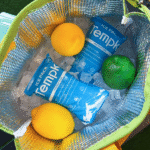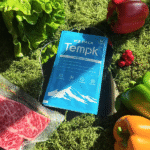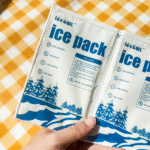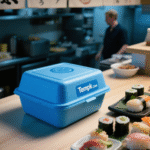Dry ice vs PCM gel packs is the single most important decision when you ship temperature-sensitive goods. Choose wrong and you risk product loss, قضايا الامتثال, and unhappy customers. Choose right and you reduce costs, minimize claims, وشحن بثقة. This article synthesizes and improves your previous drafts to deliver a 2025-ready guide.
-
درجة حرارة & physics: كيف dry ice vs PCM gel packs truly differ in performance and set-points
-
أمان & أنظمة: what handlers must do, and when hazmat rules apply
-
Best-fit scenarios: طعام, فارما, and e-grocery lane choices that actually work
-
Pack-out design: insulation first, coolant second for longer hold time
-
2025 الاتجاهات: reusables, عزل VIP, and validation habits that win
How do temperature and physics differ?
إجابة قصيرة: Dry ice vs PCM gel packs diverge on temperature and phase behavior. الجليد الجاف sits near −78.5 °C and sublimates to gas, delivering ultra-low cooling. عبوات جل PCM are engineered to freeze/melt at target set-points (for example −21 °C, +5 درجة مئوية, أو +20 درجة مئوية), giving stable temperature without gas.
لماذا يجب أن تهتم: Ultra-low is great for deep-frozen goods, but it can over-cool chilled payloads. PCMs hold a narrow band, helping you avoid cold shock and excursions. في 2025 العمليات, that stability prevents rework and cuts claims—especially in pharma and meal-kit delivery.
How do set-point PCMs avoid “over-cooling”?
During the phase change, PCMs absorb heat at a nearly constant temperature. أ +5 °C PCM buffers a 2–8 °C payload near the middle of the range, while a −21 °C PCM protects frozen foods without pushing them toward −78 °C. The result is predictable thermal behavior with safer handling and easier SOPs—no CO₂ gas and no frostbite risk for the end user.
| مقارنة | الجليد الجاف | عبوات جل PCM | معنى عملي |
|---|---|---|---|
| Working temperature | ~−78.5 °C | Custom set-point (-21 درجة مئوية, +5 درجة مئوية, +20 درجة مئوية) | Match coolant to product label |
| Phase behavior | Sublimates → gas | Melts/freezes; لا غاز | Venting vs. simple refreeze |
| حالة hazmat | Regulated UN 1845 | Non-hazmat | Labels/training vs. سهلة التعامل |
| إعادة الاستخدام | استخدام واحد | قابلة لإعادة الاستخدام | Lower cost per cycle |
| User safety | PPE required | آمنة للمس | حوادث أقل |
نصائح عملية
-
Vaccine lanes (2-8 درجة مئوية): يستخدم +5 °C PCM packs, لا 0 °C ice, to avoid cold shock.
-
الأطعمة المجمدة (−30 °C to −10 °C): Use −21 °C PCM packs for short/medium routes; dry ice for ultra-low or long haul.
-
Consumer deliveries: Avoid hazmat steps at the doorstep—prefer PCM unless ≤−40 °C is mandatory.
حالة حقيقية: A seafood shipper replaced mixed gel + dry ice with −21 °C PCMs and better insulation for 24–36 h regional lanes. Complaint rates fell, hazmat steps disappeared, and repack time dropped by one-third while maintaining temperature integrity.
When should you choose each method?
إجابة مباشرة: استخدم الجليد الجاف for ≤−40 °C or CO₂-beneficial shipments. Use PCM gel packs for −21 °C frozen, +5 °C refrigerated, أو +18/+22 °C controlled room temperature (إنبوب أشعة القطب السالب), and when you want simpler handling without hazmat paperwork.
How to decide:
-
Map product limits. If ≤−40 °C, استخدم الثلج الجاف.
-
Check restrictions. If hazmat blocks your route, اختر PCM.
-
خطة لإعادة الاستخدام. PCM programs cut recurring costs.
Pack-out design: insulation before coolant
Reducing heat gain matters more than adding coolant. VIP (لوحات معزولة فراغ) outperform thick foam, enabling smaller boxes and longer hold times. Position coolant where heat enters (أعلى / الجانبين) وتقليل مساحة الرأس.
| Pack-out factor | ما يجب القيام به | لماذا | تأثير |
|---|---|---|---|
| Box sizing | Right-size space | Less air = longer hold | انخفاض الشحن |
| العزل | Add VIP | Reduce heat gain | Extend duration |
| Coolant placement | Top/sides | Match heat path | Stable temps |
| تكييف | Follow SOP | Prevent excursions | تناسق |
Mini “How-To”:
-
Pre-stabilize payload.
-
Condition PCM or weigh dry ice.
-
Load with minimal headspace.
-
Verify with data loggers.
Shipping safety and compliance
الجليد الجاف: Needs vented packaging, وضع العلامات, والتعامل المدرب. Never make a dry-ice package airtight. ضع علامة على "الثلج الجاف/ثاني أكسيد الكربون"., صلب,” with UN 1845 وشبكة الكتلة (كجم).
حزم PCM: Usually non-hazmat—just follow supplier SDS and conditioning SOP.
أساسيات السلامة:
-
Use insulated gloves and ventilation for dry ice.
-
Confirm carrier CO₂ limits.
-
For consumer boxes, use only non-hazmat PCMs.
2025 اتجاهات السلسلة الباردة
الاستدامة & ابتكار: Reusable PCMs and VIP insulation are standardizing in global shipping. Shippers now optimize −21 °C and +5 °C programs to eliminate hazmat steps, تقليل النفايات, and validate performance with data loggers.
Key developments
-
التبريد الهجين: Combining PCMs with small dry-ice loads extends duration.
-
New PCM chemistry: Higher latent heat, tighter set-points, أوقات عقد أطول.
-
ثقافة التحقق: Summer/winter lane testing as standard practice.
نظرة السوق: E-grocery, البيولوجيا, and specialty foods drive rising demand for −21 °C and +5 درجة مئوية PCMs. Reusable packaging and closed-loop programs deliver cost and ESG gains, while dry ice remains critical for ≤−40 °C use.
الأسئلة الشائعة
س 1: Is a PCM gel pack the same as dry ice?
لا. A PCM gel pack is a reusable phase-change coolant at a specific temperature; dry ice is solid CO₂ at −78.5 °C.
Q2: When should I choose −21 °C PCMs instead of dry ice?
For frozen goods not needing ≤−40 °C, choose −21 °C PCMs for safe, non-hazmat shipping.
س 3: هل يمكنني الطيران بالثلج الجاف؟?
Yes—within airline and courier limits with venting and labeling. PCMs have no such restriction.
س 4: What causes most PCM shipment issues?
Improper conditioning and excess air space. Follow SOPs strictly.
س 5: Are PCMs safe for end customers?
نعم. They are sealed, غير سامة, وقابلة لإعادة الاستخدام.
ملخص & التوصيات
النقاط الرئيسية: Dry ice vs PCM gel packs differ in temperature, أمان, والقواعد. Dry ice covers ≤−40 °C lanes but adds hazmat overhead. PCMs handle −21 °C to +22 °C safely and efficiently. Optimize insulation before increasing coolant.
الخطوات التالية:
-
Map SKU temperature requirements.
-
Choose the lowest-hazard coolant that meets them.
-
Validate lanes by season.
CTA: Consult a Tempk cold-chain expert to optimize your set-points and packaging.
حول Tempk
We create practical, validated cold-chain packaging—reusable PCM gel packs (-21 درجة مئوية, +5 درجة مئوية, +18/+22 درجة مئوية), شاحنات VIP, and tested SOPs for frozen, مبردة, and CRT lanes. We focus on compliance, أداء, وكفاءة التكلفة.
























